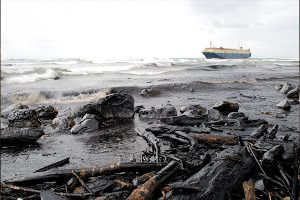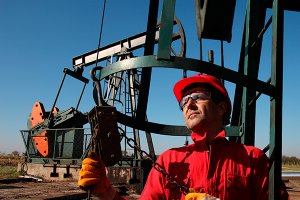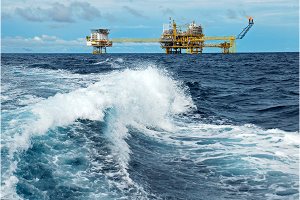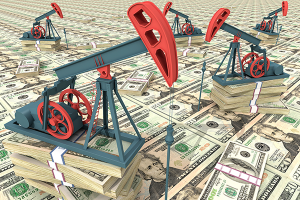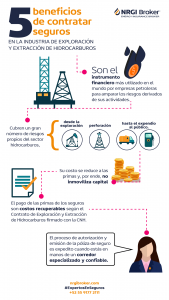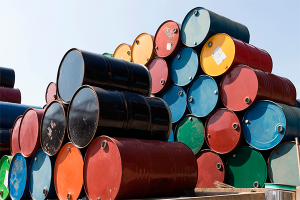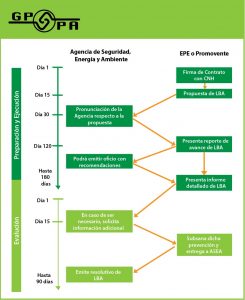Tampa Bay Times / Darryl Fears / October 22
NEW ORLEANS — An oil spill that has been quietly leaking millions of barrels into the Gulf of Mexico has gone unplugged for so long that it now verges on becoming one of the worst offshore disasters in U.S. history.
Between 300 and 700 barrels of oil per day have been spewing from a site 12 miles off the Louisiana coast since 2004, when an oil-production platform owned by Taylor Energy sank in a mudslide triggered by Hurricane Ivan. Many of the wells have not been capped, and federal officials estimate that the spill could continue through this century. With no fix in sight, the Taylor offshore spill is threatening to overtake BP’s Deepwater Horizon disaster as the largest ever.
As oil continues to spoil the Gulf, the Trump administration is proposing the largest expansion of leases for the oil and gas industry, with the potential to open nearly the entire outer continental shelf to offshore drilling. That includes the Atlantic coast, where drilling hasn’t happened in more than a century and where hurricanes hit with double the regularity of the Gulf.
Expansion plans come despite fears that the offshore oil industry is poorly regulated and that the planet needs to decrease fossil fuels to combat climate change, as well as the knowledge that 14 years after Ivan took down Taylor’s platform, the broken wells are releasing so much oil that researchers needed respirators to study the damage.
“I don’t think people know that we have this ocean in the United States that’s filled with industry,” said Scott Eustis, an ecologist for the Gulf Restoration Network, as his six-seat plane circled the spill site on a flyover last summer. On the horizon, a forest of oil platforms rose up from the Gulf’s waters, and all that is left of the doomed Taylor platform are rainbow-colored oil slicks that are often visible for miles. He cannot imagine similar development in the Atlantic, where the majority of coastal state governors, lawmakers, attorneys general and residents have aligned against the administration’s proposal.
The Taylor Energy spill is largely unknown outside Louisiana because of the company’s effort to keep it secret in the hopes of protecting its reputation and proprietary information about its operations, according to a lawsuit that eventually forced the company to reveal its cleanup plan. The spill was hidden for six years before environmental watchdog groups stumbled on oil slicks while monitoring the BP Deepwater Horizon disaster a few miles north of the Taylor site in 2010.
The Interior Department is fighting an effort by Taylor Energy to walk away from the disaster. The company sued Interior in federal court, seeking the return of about $450 million left in a trust it established with the government to fund its work to recover part of the wreckage and locate wells buried under 100 feet of muck.
Taylor Energy declined to comment. The company has argued that there’s no evidence to prove any of the wells are leaking. Last month, the Justice Department submitted an independent analysis showing that the spill was much larger than the one-to-55 barrels per day that the U.S. Coast Guard National Response Center (NRC) claimed, using data supplied by the oil company.
The author of the analysis, Oscar Garcia-Pineda, a geoscience consultant who specializes in remote sensing of oil spills, said there were several instances when the NRC reported low estimates on the same days he was finding heavy layers of oil in the field.
“There is abundant evidence that supports the fact that these reports from NRC are incorrect,” Garcia-Pineda wrote. Later he said: “My conclusion is that NRC reports are not reliable.”
In an era of climate change and warmer open waters, the storms are becoming more frequent and violent. Starting with Ivan in 2004, several hurricanes battered or destroyed more than 150 platforms in just four years.
On average, 330,000 gallons of crude are spilled each year in Louisiana from offshore platforms and onshore oil tanks, according to a state agency that monitors them.
The Gulf is one of the richest and most productive oil and gas regions in the world, expected to yield more than 600 million barrels this year alone, nearly 20 percent of the total U.S. oil production. Another 40 billion barrels rest underground, waiting to be recovered, government analysts say.
About 2,000 platforms stand in the waters off the Bayou State. Nearly 2,000 others are off the coasts of its neighbors, Texas and Mississippi. On top of that are nearly 50,000 miles of active and inactive pipelines carrying oil and minerals to the shore.
And the costs are high.
For every 1,000 wells in state and federal waters, there’s an average of 20 uncontrolled releases of oil – or blowouts – every year. A fire erupts offshore every three days, on average, and hundreds of workers are injured annually.
BP has paid or set aside $66 billion for fines, legal settlements and cleanup of the 168 million-gallon spill – a sum that the oil giant could, painfully, afford. But many companies with Gulf leases and drilling operations are small, financially at-risk and hard-pressed to pay for an accident approaching that scale.
One of them was Taylor Energy.
– – –
Taylor Energy was a giant in New Orleans.
Owned by Patrick Taylor, a magnate and philanthropist who launched an ambitious college scholarship program for low-income students, it was once the only individually owned company to explore for and produce oil in the Gulf of Mexico, according to his namesake foundation.
Taylor made what was arguably his most ambitious transaction in 1995, when he took over an oil-production platform once operated by BP. Standing in more than 450 feet of water, it was about 40 stories tall. Its legs were pile-driven into the muddy ocean floor and funnels were attached to 28 drilled oil wells.
At its peak, the oil company helped make Taylor and his wife, Phyllis, the richest couple in the Big Easy.
That investment was obliterated on Sept. 15, 2004, when Hurricane Ivan unleashed 145 mph winds and waves that topped 70 feet as it roared into the Gulf. Deep underwater, the Category 4 storm shook loose tons of mud and buckled the platform.
The avalanche sank the colossal structure and knocked it “170 meters down slope of its original location,” researcher Sarah Josephine Harrison wrote in a postmortem of the incident.
More than 620 barrels of crude oil stacked on its deck came tumbling down with it. The sleeves that conducted oil from its wells were mangled and ripped away. A mixture of steel and leaking oil was buried in 150 feet of mud.
Less than two months after the storm, Patrick F. Taylor died of a heart infection at 67, leaving a fortune for philanthropy and a massive cleanup bill.
Taylor Energy reported the spill to the Coast Guard, which monitored the site for more than half a decade without making the public fully aware of the mess it was seeing. Four years after the leak started, in July 2008, the Coast Guard informed the company that the spill had been deemed “a continuous, unsecured crude oil discharge” that posed “a significant threat to the environment,” according to a lawsuit between Taylor Energy and its insurer.
Taylor Energy made a deal with federal officials to establish a $666 million trust to stop the spill.
It would be a delicate, risky operation. Taylor and the contractors it hired were asked to somehow locate wells in a nearly impenetrable grave of mud and debris, then cap them. Failing that, it could create a device to contain the leak.
But they were forbidden from boring or drilling through the muck for fear that they would strike a pipe or well, risking the kind of catastrophe on the scale of the BP disaster a few miles south. That precaution slowed the pace of the salvage operation.
“We had no idea that any of that was going on,” said Marylee Orr, executive director of the Louisiana Environmental Action Network.
Taylor Energy spent a fortune to pluck the deck of the platform from the ocean and plug about a third of the wells. It built a kind of shield to keep the crude from rising.
But no matter what it did, the oil kept leaking.
– – –
In 2010, six years after the oil leak started, scientists studying the BP spill realized something was amiss with the oil slicks they were seeing.
“We were flying to monitor the BP disaster and we kept seeing these slicks, but they were nowhere near the BP spill,” said Cynthia Sarthou, executive director of the Gulf Restoration Network, which monitors the water from boats and planes.
Satellite images confirmed the oddity.
“It was there all the time, longer than the BP spill,” said John Amos, founder and president of Sky Truth, a nonprofit organization that tracks pollution.
Under the Oil Pollution Act, companies are obligated to report hazardous spills to the NRC, which maintains a database of chemical pollution.
No law compels the companies or the federal government to raise public awareness, but the Clean Water Act clearly calls for citizen involvement.
Environmentalists took Taylor Energy to court.
In their lawsuit, the conservationists called the agreement between Taylor Energy and the federal government a secret deal “that was inconsistent with national policy.”
That policy, they argued, was made clear in the Clean Water Act, which mandates “public participation in the . . . enforcement of any regulation.” Citizen participation, the act says, “shall be provided for, encouraged and assisted.”
Taylor Energy and the Coast Guard – which is part of a Unified Command of federal agencies that includes the Interior Department, National Oceanic and Atmospheric Administration and the Environmental Protection Agency – did not live up to the policy. In fact, the public wasn’t made aware of the spill even after a private firm tested fish in the area and submitted an assessment to Taylor Energy in 2009 that said “there is an acceptable risk to humans if fish from the . . . area are consumed.”
“Taylor has failed to provide the public with information regarding the pace and extent of the oil leaks and Taylor’s efforts to control the leaks,” the lawsuit said.
It would take another three years before the government revealed an even deeper truth. Taylor Energy had been playing down the severity of the spill. An Associated Press investigation in 2015 determined that it was about 20 times worse than the company had reported.
Taylor Energy had argued that the leak was two gallons per day; the Coast Guard finally said it was 84 gallons or more, and was almost certainly coming from any of 16 wells.
“There’s a fine for not reporting, but none for underreporting,” Amos said. “If it’s only three gallons a day, who cares, that’s a trivial problem.”
– – –
Nearly a decade after the oil platform went down, the government determined that the actual level of oil leaking into the Gulf was between one and 55 barrels per day. Now, the new estimate dwarfs that: up to 700 barrels per day. Each barrel contains 42 gallons.
Despite that finding, NOAA is still in the early stages of a resource assessment of marine life that could explain the impact of the Taylor Energy spill, and is more than three years behind a deadline to issue a biological determination of the BP spill’s impact on marine life.
In July, Earthjustice, a nonprofit legal organization that represents conservation groups, sued NOAA for failing to produce a timely study.
Like Eustis, Amos said Atlantic coast residents should be wary. But in that region, where beaches and tourism enrich nearly every state, distrust over offshore leasing and drilling is bipartisan.
Governors, state lawmakers and attorneys general lashed out at the administration’s proposal. New Jersey passed a law that forbids oil and infrastructure in state waters three miles from shore, crippling any effort to run pipelines from platforms to the shore. Other states passed similar laws.
In the Carolinas, where Hurricane Florence’s winds topped 150 mph and produced a monster 83-foot wave as it neared landfall, governors who represent both political parties implored Interior Secretary Ryan Zinke to rethink the plan.
Meanwhile, in the Gulf, Taylor Energy was down to a single employee – its president, William Pecue.
At a 2016 public forum in Baton Rouge, Pecue made the case for allowing the company to walk away from its obligation to clean up the mess. Taylor Energy had been sold to a joint venture of South Korean companies in 2008, the same year it started the $666 million trust. A third of the money had been spent on cleanup, and only a third of the leaking wells had been fixed. But Pecue wanted to recover $450 million, arguing the spill could not be contained.
“I can affirmatively say that we do believe this was an act of God under the legal definition,” Pecue said. In other words, Taylor Energy had no control over the hurricane.
But Ivan was no freak storm.
It was one of more than 600 that have been tracked in the Gulf since records were kept in the mid-1800s, according to NOAA.
Fourteen years after the Taylor spill, and 10 years after the Deepwater Horizon disaster, the federal government still doesn’t know the spills’ full impact on marine life. And there is no economic analysis showing the value of the oil flowing into the sea and potential royalties lost to taxpayers. Activists also want an analysis to determine if oil is ruining marshland and making its way to beaches.
“Even though oil did not reach a lot of these beaches [during the BP spill], the fact that the public heard about it, it killed the beach economy for quite some time,” Sarthou said. “You don’t want to go to a beach with tar balls or oil washing up.”
At the time, Sarthou was unaware that Garcia-Pineda was conducting a study in the Gulf that would show the spill was far worse than imagined – up to 10 times worse than what the federal government was reporting.
As the saga in the Gulf plays out, wary officials on the Atlantic coast are anxiously watching President Donald Trump’s proposal to offer federal offshore leases.
It would take at least a decade for Atlantic drilling to start. The industry would first want to conduct seismic testing to determine the amount of oil and gas in the ground. Depending on the results, companies would bid for the leases. Interior has yet to approve seismic testing, which some studies say harms marine life, including large mammals such as dolphins and whales.
Oil and gas representatives say energy development off that coast could provide South Carolina with $2.7 billion in annual economic growth, 35,000 jobs and potentially lower heating costs for residents struggling to pay their bills.
During a federal informational hearing in South Carolina to explain the Trump administration’s plan in February, Mark Harmon, the director of a state unit of the American Petroleum Institute, stressed that point. “Ultimately, it means the potential for jobs and reinvestment in the community,” he said.
Once the oil industry gains a foothold in a region, it’s game over, said Chris Eaton, an Earthjustice attorney.
“A major part of the economy starts to change” as jobs with pay approaching $100,000 transform a tourism market to oil. “If it gets going, that train isn’t going to stop,” he said. “Let’s talk about what’s happening in the Gulf before we move into the Atlantic.”
Tampa Bay Times / Darryl Fears / October 22
